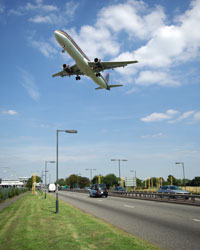Report calls on the Airports Commission to adequately consider surface access

Image: Thinkstock
A report - Surface Connectivity: assessing the merits of the Airports - undertaken by Loughborough University for the Independent Transport Commission (ITC) is released today (Wednesday 29 October).
The report, by Dr Tim Ryley and Dr A M Zanni from the University’s School of Civil and Building Engineering is timely, since the Government’s Airports Commission will shortly publish its latest analysis and will make its final recommendations by next Summer.
The report calls for stronger focus on the surface transport implications of airport expansion, whether at Heathrow or Gatwick. Expanding an airport without a clear plan for surface access will deliver only half the solution. No-one simply flies: all airline journeys start-and-end with surface journeys to their final destination. But this issue has attracted far too little attention.
The report found:
- Travel to and from airports in South-East England will rise due to expansion and underlying population growth.[1] It remains, however, unclear just how much additional rail, road and tube capacity - on top of what is already planned - will be needed once underlying population growth, the additional demand (from passengers, staff and freight), and a significant switch to public transport are all factored in. Robust modelling of these combined effects is urgently needed to test the adequacy and cost of surface transport proposals.
- The targets for modal shift - from private cars to public transport – set by the airports are ambitious, and policies to encourage behavioural change, as well as investment, will be necessary to achieve them.
- The “last mile at the airport” - ensuring easy and seamless transition between the plane and surface transport - is critical for passengers. This raises issues and opportunities for new technology, integrated ticketing, local transport ‘hubs’, and ensuring that airports are well integrated with the national transport network.
- Planning and then operating seamless transport to and within major airports is complex. It involves a host of organisations, including planning authorities, property owners, infrastructure providers and service operators. Effective “governance” will be crucial.
- An opportunity may have been lost to plan the UK’s 2 biggest transport proposals - HS2 and airport expansion - in the joined-up way that other countries have adopted, to maximise the benefits from both. But HS2 could create a new “airport corridor” between the south, midlands and north, creating new commercial and competitive opportunities for airlines.
The report therefore recommends that the Airports Commission should:
- Publish clear and transparent estimates of the cumulative extra demand which would follow from expansion; and whether the currently planned surface transport improvements will be sufficient for the next 30+ years;
- Consider the policies, including possible financial penalties and incentives, to encourage mode switch to public transport and funding streams to support it. This could make a contribution to the investment needed;
- Propose appropriate public-private governance structures to ensure that the full benefits for passengers of seamless transitions between plane and surface transport are realised during the planning and execution stages;
And calls on the Government to:
- Reflect on the integration between airport development and high-speed rail achieved elsewhere (eg Amsterdam, Frankfurt and Paris) and consider what better mechanisms might be needed to strengthen cross-modal planning for future major transport proposals.
Dr Stephen Hickey, Chairman of the ITC’s Aviation working group, commented:
"Expanding an airport without an adequate surface transport strategy would deliver only half the solution. But the surface connectivity issues have been largely absent from public debate.
The report comes at an important time for the Airports Commission, who will decide on their final recommendations in the next few months. It is essential that, whichever airport they recommend for expansion, they don’t look at aviation in isolation. Passengers start and end every journey on surface transport, so this also needs to be fit for purpose. But the population is rising anyway, and there also needs to be a switch to public transport, so it is vital to ensure the cumulative demands on the surface systems can be met and that passengers can move easily and seamlessly between their surface journeys and their flights. Improving global and domestic connectivity must go hand in hand."
This study builds upon the following previous ITC reports on UK aviation strategy: Flying into the Future (May 2013), and The optimal size of a UK hub airport (February 2014).